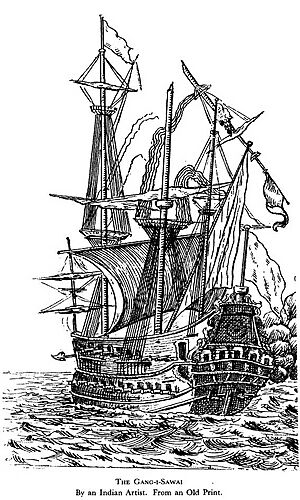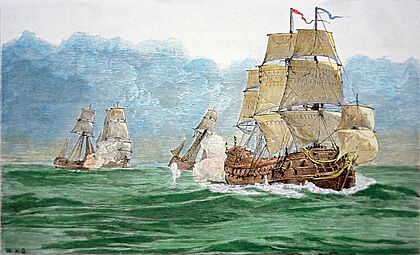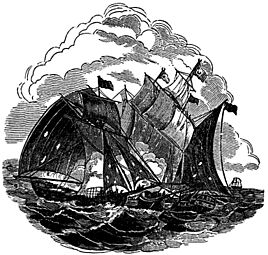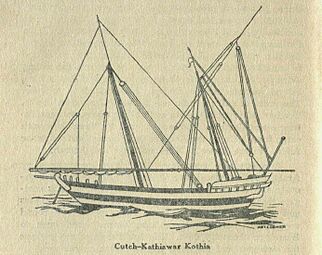Ganj-i-Sawai facts for kids
The Ganj-i-Sawai (pronounced Gunj-ee-Suh-wai) was a huge and powerful trading ship belonging to the Mughal Empire in India. Its name means "Exceeding Treasure" in Persian, and it certainly lived up to that name! This amazing ship was built in 1616 by order of Empress Mariam-uz-Zamani, who was the great-grandmother of Emperor Aurangzeb. The Ganj-i-Sawai was a Ghanjah sailing ship, a type of large wooden vessel used for trade. It was very big, weighing between 1500 and 1600 tons. It also carried many people, usually between 1100 and 1300, including 400 to 500 soldiers to protect it. The ship was also armed with 40 to 80 cannons.
The Ganj-i-Sawai was famous for carrying valuable goods and pilgrims on their way to Mecca for the Hajj (a religious journey). However, its most famous journey ended on September 7, 1695, when it was captured by the English pirate Henry Every while sailing from Mocha, Yemen to Surat, India.

A later (1933) interpretation of Ganj-i-Sawai. The ship is inaccurately depicted as an East Indiaman.
|
|
Quick facts for kids History |
|
|---|---|
| Name | Ganj-I-Sawai |
| Owner |
|
| Ordered | In 1614 by Empress Mariam-uz-Zamani |
| Launched | 1616 |
| Completed | 1616 |
| Maiden voyage | 1617 |
| Out of service | 7 September 1695 |
| Fate | Seized by pirates |
| General characteristics | |
| Type | Ghanjah sailing ship |
| Displacement | 1500 to 1600 tons |
| Complement | 1100–1300 total, 400–500 of which were soldiers |
| Armament | 40–80 guns/ 800 guns |
Contents
A Pirate's Daring Capture
In August 1695, the famous pirate Henry Every was sailing his ship, the Fancy, near the Mandab Strait. He joined forces with five other pirate captains, including Thomas Tew on the Amity. They were all hoping to find a rich prize.
The Chase Begins
The pirates knew a large group of 25 Mughal ships was heading towards India. They missed the main group during the night. But the next day, they spotted two ships that had fallen behind. These were the Ganj-i-Sawai and its escort ship, the Fateh Muhammed. The Fateh Muhammed was even larger than the Ganj-i-Sawai and had 94 cannons!
Henry Every and his crew first attacked the Fateh Muhammed. This ship had already fought off an attack by Thomas Tew's ship, and Captain Tew was killed in that fight. Perhaps because they were tired or scared by the Fancy's many cannons, the crew of Fateh Muhammed didn't fight very hard. Every's pirates quickly took over the ship and found a huge amount of treasure, worth about £40,000.
The Battle for the Treasure Ship
After taking the Fateh Muhammed, Every chased the Ganj-i-Sawai. He caught up with it about eight days later. The Ganj-i-Sawai was a tough opponent. It had 62 cannons and carried hundreds of armed guards, plus many other passengers.
However, the battle started badly for the Ganj-i-Sawai. One of its own cannons exploded, causing chaos and fear among its crew. At the same time, Every's ship fired a powerful volley, hitting the Ganj-i-Sawai's main mast and breaking it. The Fancy then pulled alongside the damaged Ganj-i-Sawai. Many of Every's 113 crew members climbed aboard. They quickly overpowered the crew and passengers of the Ganj-i-Sawai.
The pirates then spent several days searching for the ship's treasure. They used harsh methods to make people tell them where the valuables were hidden. The treasure found on the Ganj-i-Sawai was enormous! It was worth between £325,000 and £600,000. This included about 500,000 gold and silver coins, along with many jewels and silver items.
After gathering all the treasure, Every was supposed to share it with the other pirate crews. But under the cover of night, Every and his crew quietly sailed away from the other pirate ships. They took all the Ganj-i-Sawai's treasure for themselves!
What Happened After the Capture?
The capture of the Ganj-i-Sawai made the Mughal Emperor, Aurangzeb, very angry. He ordered his army to close five important ports in India where English traders did business. Aurangzeb said he would not reopen the ports until Henry Every was caught and punished.
The East India Company, which was a powerful English trading company, had to make things right with the Emperor. They paid a large amount of money to make up for the losses, even though the Mughal authorities demanded double the amount.
The desire to catch Henry Every led to the first truly global manhunt in history. Even with such a huge search, Every and most of his crew were never caught. Six members of his crew were captured, put on trial, and executed. However, they were found guilty of attacking a different ship, not the Ganj-i-Sawai.
Gallery
See also
- Rahīmī (Mughal ship)
- Child's War
- Dhow
- Baghlah
- Ghanjah
- Chinese treasure ship
- Javanese jong




